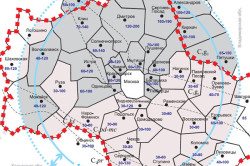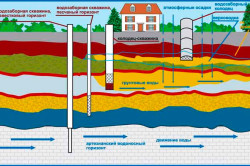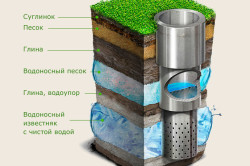Classification
According to the conditions of occurrence, groundwater is divided into:
- soil;
- ground;
- interstratal.
Soil water fills part of the gaps between soil particles; they can be free (gravitational), moving under the influence of gravity, or bound, held by molecular forces.
Ground water form an aquifer on the first water-resistant layer from the surface. Due to the shallow bedding from the surface, the groundwater level experiences significant fluctuations according to the seasons of the year: it either rises after precipitation or snow melts, then decreases in dry times. In severe winters, groundwater can freeze through. These waters are more susceptible to pollution.
Interstratal waters- underlying aquifers, enclosed between two water-resistant layers. Unlike groundwater, the interstratal water level is more constant and changes less over time. Interstratal waters are cleaner than groundwater. Pressurized interstratal waters completely fill the aquifer and are under pressure. All waters enclosed in layers lying in concave tectonic structures have a head.
According to the conditions of movement in aquifers, groundwater is distinguished, circulating in loose (sandy, gravel and pebble) layers and in fractured rocks.
Depending on the nature of the voids of the water-bearing rocks, groundwater is divided into:
- pore- in sands, pebbles and other detrital rocks;
- fissure(vein) - in rocks (granites, sandstones);
- karst(fissure-karst) - in soluble rocks (limestone, dolomite, gypsum, etc.).
Groundwater reserves
Groundwater exploration
To determine the presence of underground water, exploration is carried out:
- pilot wells are drilled with selection core ,
- core is studied and determined relative geological age rocks their thickness (thickness),
- experimental pumping is carried out, characteristics are determined aquifer, an engineering-geological report is drawn up;
- but for several reference wells, maps, sections are drawn up, a preliminary assessment of mineral reserves (in this case, water) is carried out;
Origin of groundwater
Groundwater has a different origin: some of them were formed as a result of the penetration of melt and rainwater to the first water-resistant horizon (that is, to a depth of 1.5-2.0 m, which form groundwater, i.e. the so-called verkhovodka); others occupy deeper cavities in the ground.
see also
Links
- Taking into account the influence of groundwater in the design of foundations
Literature
- Lange O. K. Underground waters of the USSR, parts 1-2, M., 1959-1963.
Wikimedia Foundation. 2010.
See what "Groundwater" is in other dictionaries:
Waters below the surface of the earth and circulating in rock strata. G. in. ch. arr. from the absorption of rain and melt water into the ground, and in some cases from the absorption of water brought by rivers or artificial canals. Under… … Technical Railway Dictionary
Theme: Sushi waters; origin, groundwater protection
Educational tasks:
Form the concepts: group waters, interstratal waters, springs. Give information about the origin of groundwater.
Lesson equipment:
1. Map of the hemispheres
2. Physical map of the USSR (Russia)
I.Repetition of the passed material.
1. How lakes differ from the seas.
2. What are the lakes.
3. How is the salinization of lakes.
4. What types of lakes do you know by origin.
5. What is formed after the construction of a hydroelectric power station
Give the concept of landslide lakes, lakes of oxbow lakes, glacial lakes.
II. Learning new material:
Origin of groundwater:
Groundwater is water found in pores, voids and cracks in rocks in the upper part crust.
They are formed due to the seepage into the depths of the earth of rain and melt water. Groundwater replenishment occurs later due to water vapor contained in the air. The air, penetrating the upper part of the lithosphere, cools and forms tiny droplets of water (dew) from water vapor.
The origin of groundwater is a complex process of interaction of the hydrosphere and atmosphere with the lithosphere.
Permeable and impermeable reservoirs
Water-permeable gravel beds
pebble
The rate of percolation of groundwater depends on the permeability.
Through pebbles, water can seep up to 100 m per day through sand up to 10 m, but through clay by 1 mm. Seams that do not allow water to pass are called w o d o u p o r n and
clay granite sandstone shale.
Since the upper part of the earth's crust has a complex structure and layers can consist of both waterproof and permeable rocks, the groundwater is overlain in layers.
Layers of impermeable rocks containing water are called aquifers
Ground water level.
Groundwater is in the aquifer, overlying the first water-resistant stratum are called unpaved, and groundwater trapped between two impervious strata are called interstratal.
The surface of the groundwater is called groundwater level ... The groundwater level depends on:
1. Amount of optimal precipitation
2. From the rugged terrain
3. From the proximity and high flow of rivers and lakes (the level of groundwater decreases towards the watersheds)
But if the rivers are full-flowing, then they can feed groundwater. In these cases, the groundwater level decreases with distance from water bodies.
Groundwater use.
If the water-resistant layer has a slope, then the water begins to flow and forms:
The water of the springs is used for their needs by the rural population. Most often, groundwater is obtained from wells. Wells are drilled in order to extract interstratal water, and the water comes out to the surface under pressure. Such waters are called artesian.
population
Fresh underground water goes to
Pasture
Mineral and thermal underground waters.
Mineral water is a water in which salts and gases are dissolved in large quantities.
Used for healing. Hospitals and health resorts are built on these springs.
Resorts in the Caucasus:
1. Borjomi;
2. Essentuki;
3. Kislovodsk.
In ancient times, people could not explain the origin of the sources and considered them saints.
Groundwater can be hot and thermal. Thermal waters heat greenhouses, housing, houses, baths. Several power plants operate on normal waters. In our country, it was built in Kamchatka.
Protection of underground waters.
Currently, water from wells is used a lot, through which interstratal water is pumped out. Its number is decreasing. They must be used wisely. Groundwater is a precious part of the world's freshwater supply.
Homework
Repeat § 39, study text.
Questions for consolidation.
1. What is the difference between groundwater and interstratal waters?
2. What does the groundwater level depend on?
3. How is groundwater used?
Geographical dictation.
1. Most deep lake the world (Baikal).
2. Lake of tectanic origin in Africa (Tanganyika)
3. Landfall lake in the Pamirs (Sarez)
4. Endless lakes in Russia (Caspian Sea)
5. Waste lakes in the north of the European part of Russia (Ladoga, Onega)
6. The channel through which you can go from the Volga River to the Black Sea (Volgo-Don)
Question 1. What is the hydrosphere?
The hydrosphere is the watery shell of the Earth. The totality of the waters of the seas, oceans, continental bodies of water, rivers, underground sources, swamps and ice sheets of the Earth.
Question 2. What parts does the hydrosphere consist of?
The totality of the waters of the seas, oceans, continental bodies of water, rivers, underground sources, swamps and ice sheets of the Earth.
Question 3. How does water get to the surface of the Earth?
Water falls out of the clouds in the form of rain, snow, hail. Also settles in the form of frost, dew, fog.
Question 4. Is the presence of glaciers an advantage of any territory?
Yes, since huge reserves of fresh water are concentrated in them.
Question 5. What is groundwater?
Groundwater - all water in the rock mass.
Question 6. What are the types of groundwater.
There are two types of groundwater: groundwater and interstratal. Groundwater occurs on the first waterproof layer from the surface. Interstratal waters occur between two impermeable layers.
Question 7. What rocks are called waterproof?
Impervious rocks are dense, fractured rocks such as clay.
Question 8. What is an aquifer?
An aquifer, rocky formation, often sandstone or limestone, that is capable of both storing and letting water through due to its permeability and porosity.
Question 9. What is a glacier?
Glaciers are huge masses of ice several hundred meters thick located on mountain slopes or in the polar regions of the Earth.
Question 10. What types of glaciers are there?
According to their appearance and the nature of their movement, glaciers are divided into two main types - continental (cover) and mountain ones.
Question 11. What is a snow line?
Snow line - level the earth's surface above which the accumulation of solid atmospheric precipitation prevails over their melting and evaporation.
Question 12. What is the difference between groundwater and interstratal?
Groundwater - groundwaters of the first permanent aquifer from the surface, lying on the first water-resistant stratum that is consistent in terms of area. Interstratal waters - located deeper - there are pressure artesian and deep.
Question 13. What natural conditions contribute to the formation of groundwater?
One of the main ways of the formation of groundwater is the percolation of atmospheric precipitation and surface waters(lakes, rivers, seas, etc.).
Question 14. What determines the height of the position of the snow line?
The snow line is formed under the influence of the climatic characteristics of a given territory, first of all, the ratio of heat and moisture, as well as the relief. The snow line is dropping in cold and wet areas and rises in warm and dry conditions.
Question 15. What conditions are necessary for the formation of a glacier?
The general condition for the formation of glaciers is a combination low temperatures air with a large amount of solid precipitation, which occurs in cold countries of high latitudes and in the summit parts of the mountains.
Question 16. Analyze thematic maps of the atlas and name mountain systems the world within which mountain glaciers exist.
North America - Cordillera, South America- Andes, Eurasia - Alps, Caucasus, Himalayas, Altai, Pamir.
For the purpose of water supply, underground waters, open reservoirs and atmospheric waters can be used.
1. Groundwater
Groundwater is formed mainly through the filtration of precipitation through the soil; a small part of them is formed as a result of filtration of water from open reservoirs (rivers, lakes, reservoirs, etc.) through the channel.
The accumulation and movement of groundwater depend on the structure of rocks, which in relation to water are divided into waterproof (waterproof) and permeable. Water-resistant rocks are granite, clay, limestone; permeable include sand, gravel, pebbles, fractured rocks. Water fills the pores and cracks in these rocks. Groundwater according to the conditions of occurrence are divided into soil, groundwater and interstratal.
a) Soil waters (surface or upper water) lie most closely to the earth's surface in the first aquifer, do not have protection in the form of an impermeable layer, therefore, their composition changes dramatically depending on hydrometeorological conditions. Most of them accumulate in the spring, in the summer they dry out, in the winter they freeze. They are easily contaminated, since they are in the zone of atmospheric water seepage and therefore should not be used for water supply.
b) Groundwater is located in subsequent aquifers; they accumulate on the first waterproof layer, do not have a waterproof layer on top, and therefore water exchange occurs between them and surface waters. The groundwater is free-flowing, its level in the well is set at the level of the underground water layer. They are formed due to the percolation of atmospheric precipitation and the water level is subject to large fluctuations in different years and seasons. Groundwater has a more or less constant composition and better quality than surface water. Filtered through a fairly significant layer of soil, they become colorless, transparent, free of microorganisms. The depth of their occurrence in various localities ranges from 2 m to several tens. Groundwater is a common source of water supply in rural areas.
Comments:
Water is the source of life on Earth, without it it is difficult to imagine the activities of modern man. Water is used for different purposes: drinking and household needs, watering for livestock. Those who live in the private sector far from the city know that the main sources of drinking water are wells, boreholes or drainage. In one case or another, it is necessary to conduct water on its own. Determining the exact location of the aquifer is of great importance. The location of the aquifers varies in depth, and the quality of the water largely depends on this.
Each level of the water carrier has its own characteristics. Depending on this, several types of underground veins are distinguished: verkhovodka, groundwater and interstratal waters. The latter are divided into pressure and non-pressure. They are the cleanest, but at the same time, they are the most difficult to get to. Hydrogeological features are important not only when conducting a water supply system, but also in construction. At the same time, the level of standing of groundwater is of great importance. Let us consider in more detail the difference between the upper waters, groundwater and interstratal waters, what is their depth.
Aquifers of the earth

There are several aquifers in the earth. Water accumulates in the ground due to the presence of waterproof layers. The latter are formed, to a greater extent, by clay. Clay practically does not allow water to pass through, thereby protecting aquifers from pollution. Less often, stones can be found in a water-resistant layer. An interesting fact is that between the clay layers there are almost always layers formed by sand. It is known that sand retains moisture (water), as a result of which water accumulates and thereby forms the aquifers of the earth. You need to know that aquifers can be protected by water-resistant strata on both sides or only on one side.
The deepest aquifer used in modern times for water consumption, formed by artesian waters. It can be located at a depth of over 100 meters. Artesian waters do not occur in a layer of sand, but in a layer formed by limestone. Thanks to this, they have a special chemical composition... There are also more accessible aquifers. These include verkhovodka. It is of great importance that it is not protected from above by a waterproof layer, therefore it is not suitable for drinking needs. Aquifers can be thin in some areas and very large in others. This is observed as a result of fracture of water-resistant formations. Such areas have a large debit.
Verkhovodka and its features

The very first aquifer is called the upper water layer. This water got its name due to the fact that the layer is located very close to the surface. The depth at which it can be detected ranges from 1 to 4 meters. Verkhovodka refers to non-pressurized groundwater. Such water is not available everywhere, therefore it is a non-permanent aquifer. Verkhovodka is formed as a result of filtration of surface water or precipitation through the soil. Because of this, it has not found wide application for drinking needs. There are several reasons for this:
- low flow rate and its inconsistency;
- the presence of a large amount of pollutants;
- impossibility to fully meet the needs of the population.
Verkhovodka is formed periodically. It depends on the presence of precipitation, floods. It is very difficult to find this water source in the warm season (summer). Often, it is located on the first water-resistant layer, therefore, when this layer emerges, a swampy area may form. The water of this aquifer is characterized by the fact that it is fresh, has a low salinity. In addition, it is contaminated with organic matter. In some cases, it contains a lot of iron. It can be suitable for household needs as an additional source of water for irrigation or irrigation of plants.
Characteristics of groundwater

Determination of the level of standing groundwater in private construction is observed very often. They are most often used for water supply in the residential sector. Wells or capturing are built for the intake of groundwater. Wells are more often drilled for interstratal waters. Groundwater forms the first permanent aquifer, which lies on the first water-resistant layer of the earth. They are non-pressurized. This indicates that they are not protected from above by water-resistant soil rocks, while the layer of the earth itself remains half-filled.
They are widespread almost everywhere, in contrast to the verkhovodka. It is important that groundwater is largely dependent on precipitation, so their flow rate may vary depending on the season. In spring and autumn, it is higher than in summer and winter. The level of this layer repeats the configuration of the relief, therefore, the thickness of this layer is different in different territories. The water that accumulates in the alluvial bowels is widely used for drinking. Groundwater occurs at a level of several meters to tens. The chemical composition and mineralization are determined by the location of the layer. If there are surface sources(rivers, lakes) with fresh water, then the underground layers can be used for drinking, washing and other purposes. But this requires cleaning them (boiling or filtering).
Interstratal aquifers
When choosing an aquifer for a future well or well, you need to know that interstratal waters are of better quality (cleaner), in contrast to groundwater.
Interstratal waters are characterized by the fact that they are surrounded by waterproof layers above and below.

The depth at which they can be found ranges from 10 meters or more. Distinguish between gravity and pressure interstratal waters. The former are not so widespread and very difficult to find. They are found in layered sediments at the top of the geological section. According to their chemical composition, they are more balanced and cleaner, therefore they are used for water supply.
The most popular are pressurized waters called artesian. It was found that their chemical composition is constant. They are rich in various minerals. This water can be drunk even without pretreatment. This aquifer is protected from above and below. Their debit is always large and constant. The depth of their location is about 100 meters or more. It is to obtain artesian water that wells are drilled. Artesian water is a valuable mineral.
How does water quality depend on the depth of the aquifer?
Where aquifers are located, it is believed that water quality improves with increasing depth. This is actually the case. In the course of private construction of wells or wells, the first water begins to appear already at a depth of 2-3 meters from the surface. This is the water of the first aquifer. She's dirty chemicals, organic matter that comes from the surface. Wastewater is of great importance and easily penetrates into the first aquifer. When building a well, the optimal digging depth is 15-20 meters.
Here groundwater and interstratal waters occur. To find the artesian vein, you need to dig further. In this case, it is better to use drilling. Thus, the occurrence of aquifers is of great importance for the water supply of the population. Many regions lack pure water, which is the reason for the search for new sources.




